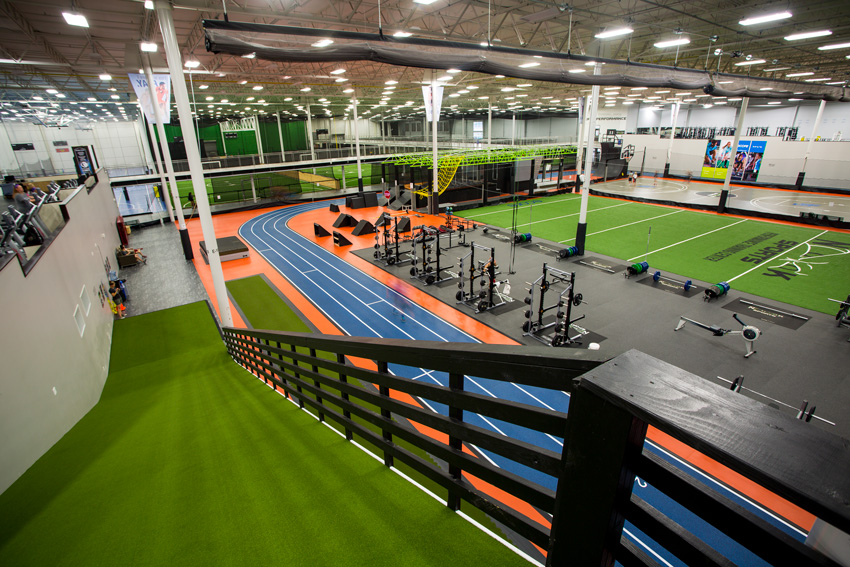Defining Performance in Flooring
Performance Floors: Ergonomics

Spooky Nook Sports, in Manheim, Pennsylvania, the largest indoor sports complex in North America, uses different performance flooring solutions for areas with different functions.
“Ergonomics” is a broad term with many meanings in different settings, but however it is defined, the mechanics of how the human body reacts to surrounding physical conditions has real consequences for the health and productivity of people in all activities, from standing in an office workspace to exercising in a gym. An ergonomic chair is designed to support the body in ways that avoid injury and promote healthy posture. What is an ergonomic floor?
A performance surface can provide support, prevent fatigue and injury, and promote good mobility. As with other elements of performance, the balance depends on the activities in the space. For example, a very soft, cushioned floor in a hospital corridor might be extremely comfortable for staff—as long as they just stand there. But since most of the day they are actually moving quickly and pushing or pulling heavy equipment, an overly soft floor would be an unsafe nuisance. Ergonomically efficient flooring balances the absorption of force and the return of energy.
The classic comparison illustrating these concepts is a floor of concrete versus a beach of sand. Concrete has very little force reduction (-1.9 percent) and very high energy restitution (77.2 percent). In the case of a footstep, this means that the floor returns virtually all the force of the footstep to the feet, legs, and body of the walking person. Concrete is hard and uncomfortable and has no “give.”
At the opposite end of the spectrum, sand has very high force reduction (82.7 percent) and very low energy restitution (0.5 percent). Virtually no energy is returned to the person, it is all absorbed, there is too much “give,” and walking becomes very difficult.
Force reduction and shock absorption tend to add levels of safety, while energy restitution and “bounce” enhance performance and durability. For any given application, the ideal surface for the space will achieve the right balance between the two.
For example, trends in fitness are moving toward functional training, which focuses on strength and conditioning—jumping, sprinting, throwing, and crawling. The ability to customize performance for activities in spaces with specific purposes was important when Spooky Nook Sports, the largest indoor sports complex in North America, renovated six tennis courts to create a functional training area that includes a performance track, turf field, basketball court, weight-lifting area, and many other specialized spaces such as sled lanes and obstacle courses, all with different performance surfaces supporting different activities. The basketball court surface, for example, is an engineered floor with a surface that mimics real wood but is more durable and features a composition rubber backing. In the new weight-lifting area, fitted with cutting edge inlaid lifting platforms, the surface is a 22.5-millimeter system comprised of three layers of composition rubber to ensure good force reduction and energy restitution.
Flooring concepts such as coefficient of friction (COF), sliding effect, vertical deformation, and others discussed in the next section on safety are also closely related to ergonomic performance. It is important to balance the physical characteristics of the flooring based on the specific needs of the space for safety, mobility, and ergonomic response.
Key Ergonomics Terms and Criteria
- Force reduction: How much energy a surface absorbs; for example, when a person walks on it. A surface of concrete would have extremely low force reduction because it absorbs very little energy, returning most of it back to the person’s feet, legs, and body.
- ASTM F2569 – 11: Standard Test Method for Evaluating the Force Reduction Properties of Surfaces for Athletic Use.
- Energy restitution: How much the surface returns energy. A surface of sand has very little energy restitution and a high force reduction, meaning it will absorb almost all the energy and return very little back to the person’s body, making walking difficult.
- Elasticity: A term often used to evaluate sports flooring, indicating how the surface responds to an athlete. The basic types are area elasticity, where the downward force of a footfall (for example, a basketball player’s sneaker) is dispersed over a wide area, and point elasticity, where the force (for example, from a high heel shoe) would be concentrated in a smaller area. There are also combination floors with levels of both types of elasticity.









